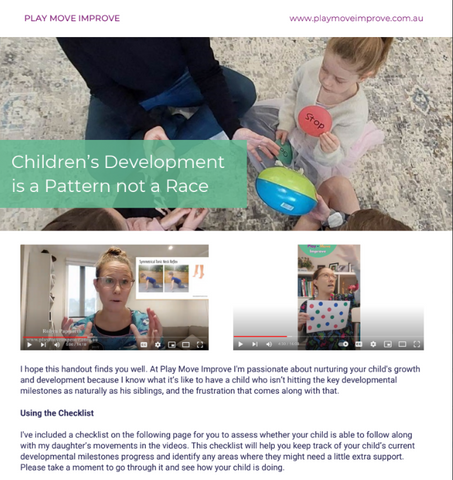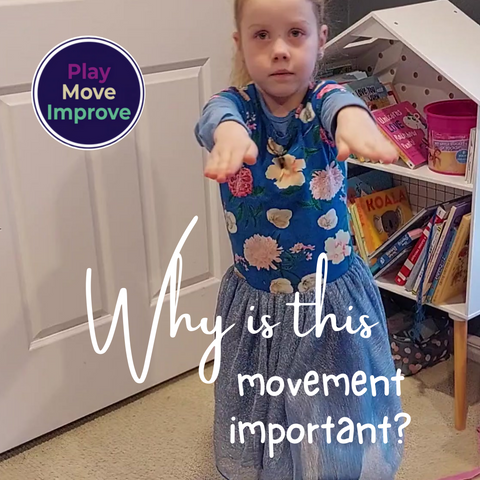Building Blocks for Kindergarten Success: Early Motor Development and Focus
As a pediatric Exercise Physiologist, I've been privileged to witness the incredible journey of infants, toddlers, preschoolers and primary school aged children as they grow and develop.
In this blog post, we'll explore the intricate connection between the development of infantile reflexes, motor skills, and a child's ability to sit still and focus in kindergarten and school. You're also welcome to check out my quick video about reflexes in this video below.
I'll also provide practical activity examples categorised into tummy time, floor play, outdoor movement, and sensory play to support this developmental journey. Learn more here
Laying the Foundation: Infantile Reflexes
Infantile reflexes are innate movements that infants are born with. These reflexes are automatic responses to specific stimuli and are crucial for survival in the early stages of life. Examples include the Moro reflex (startle response), STNR reflex (moving the head without arms and hips moving), ATNR reflex (move the head side to side without movement of the elbow and hips), and grasp reflex (grabbing an object placed in the hand).
-
Moro Reflex:
- What it is: The Moro reflex is a baby's instinctual response to a sudden startle or loud noise, where they spread their arms wide and then bring them back in.
-
Why it's important: This reflex helps babies respond to potential dangers and also aids in developing their coordination and sense of balance. When it integrates, it contributes to the ability to sit still and pay attention in class. If it doesn't integrate, children are easily distracted by sounds in the classroom.
-
STNR (Symmetrical Tonic Neck Reflex):
- What it is: STNR is a reflex that occurs when a baby flexes their head forward, their arms bend, and their legs straighten, or when they extend their head back, their arms straighten, and their legs bend. This is important for babies to learn how to crawl. However, extremely agitating when children are trying to sit at the table to eat snack without their arms and legs feeling agitated.
-
Why it's important: This reflex lays the foundation for crawling and coordinated movement. Its integration is essential for good posture, which is needed for focused learning.
-
ATNR (Asymmetrical Tonic Neck Reflex):
- What it is: ATNR happens when a baby turns their head to one side, causing the arm on that side to extend while the opposite arm bends. It's an important reflex for a safe delivery at birth, and to develop the skill of rolling.
-
Why it's important: ATNR helps babies reach and explore their surroundings. When integrated, it aids in fine motor skills development, such as holding pencils and focusing on tasks. However, if this reflex stays present in kindergarten, it can make fine motor skill development and staying focused during puzzles challenging.
-
Palmar Reflex:
- What it is: The palmar reflex occurs when you touch a baby's palm, causing them to grip your finger tightly. We feel this reflex when a baby grabs onto our hair and struggles to let go.
- Why it's important: This reflex is essential for the development of hand strength and coordination. Its integration supports skills like writing and using scissors in kindergarten.
If you'd like to see if children are finding reflex development challenging, check out this free reflex movement checklist.
I'm here to help if you have any questions or need one on one online support.
The Developmental Pathway
During the first year of life, these reflexes serve as the foundation for more complex motor skills. As infants grow and their nervous systems mature, they begin to integrate these reflexes. Integration means that these reflexes no longer dominate a child's movements, allowing for controlled and purposeful actions.
We're seeing more and more children starting 3 year old kindergarten with these reflexes still present and it's impacting children's ability to play, focus, learn and develop more complex skills that they will need for kindergarten, school and life.
The Connection to Kindergarten Success
Let's explore how the integration of infantile reflexes connects to a child's ability to sit still and focus in kindergarten:
-
Postural Control: Reflex integration plays a pivotal role in developing postural control. This postural stability allows children to sit comfortably at a desk or on a mat in kindergarten without fidgeting, slouching or leaning against furniture or other children.
-
Attention Span: Integrated reflexes enable children to focus their attention on specific tasks without being frequently interrupted by involuntary movements, thereby enhancing their attention span for classroom activities and learning.
-
Fine Motor Skills: Reflex integration contributes to the development of fine motor skills, which are vital for tasks such as holding a pencil, using scissors, or manipulating objects on a table.
Activities to Support Reflex Integration for Kindergarten Readiness
Here are practical activity examples categorised into four key areas: tummy time, floor play, outdoor movement, and sensory play.
1. Tummy Time:
- Activity: Place your baby on their tummy for short periods each day. Or encourage older children to engage in their favourite activity on their tummy, starting at 2 minutes duration and slowly building their endurance to 10 minutes of tummy time each day when at kindergarten age.
- Benefits: Strengthens neck and upper body muscles, crucial for head control, visual tracking, and future fine motor skill development.
2. Floor Play:
- Activity: Encourage reaching and rolling each day, reaching with both hands, and rolling towards both sides in a straight line.
- Benefits: Promotes core strength, reflex integration, core strength, visual tracking, fine motor skill development, crawling, etc.
3. Outdoor Movement:
- Activity: Visit a local park and allow your child to explore the environment. If your child is reluctant, give them 5 movements to complete off of a check list, or set up a timed challenge to add motivation.
- Benefits: Outdoor play encourages balance, coordination, sensory stimulation, and spatial awareness.
4. Sensory Play:
- Activity: Create a sensory bin with different textured materials (e.g., rice, sand, or water beads) and hide small objects in the bin for children to search for with their hands, spoon, dry paint brush, etc.
- Benefits: Engaging in sensory play enhances sensory perception and fine motor skills.
The journey from reflexes to focus and attention is remarkable. Understanding how infantile reflexes are linked to a child's ability to sit still and focus in kindergarten can guide you in creating a supportive environment for early motor development.
By incorporating these activity examples, we can empower our children for success in the classroom and beyond. Learn more in our reflex webinar below.





Leave a comment